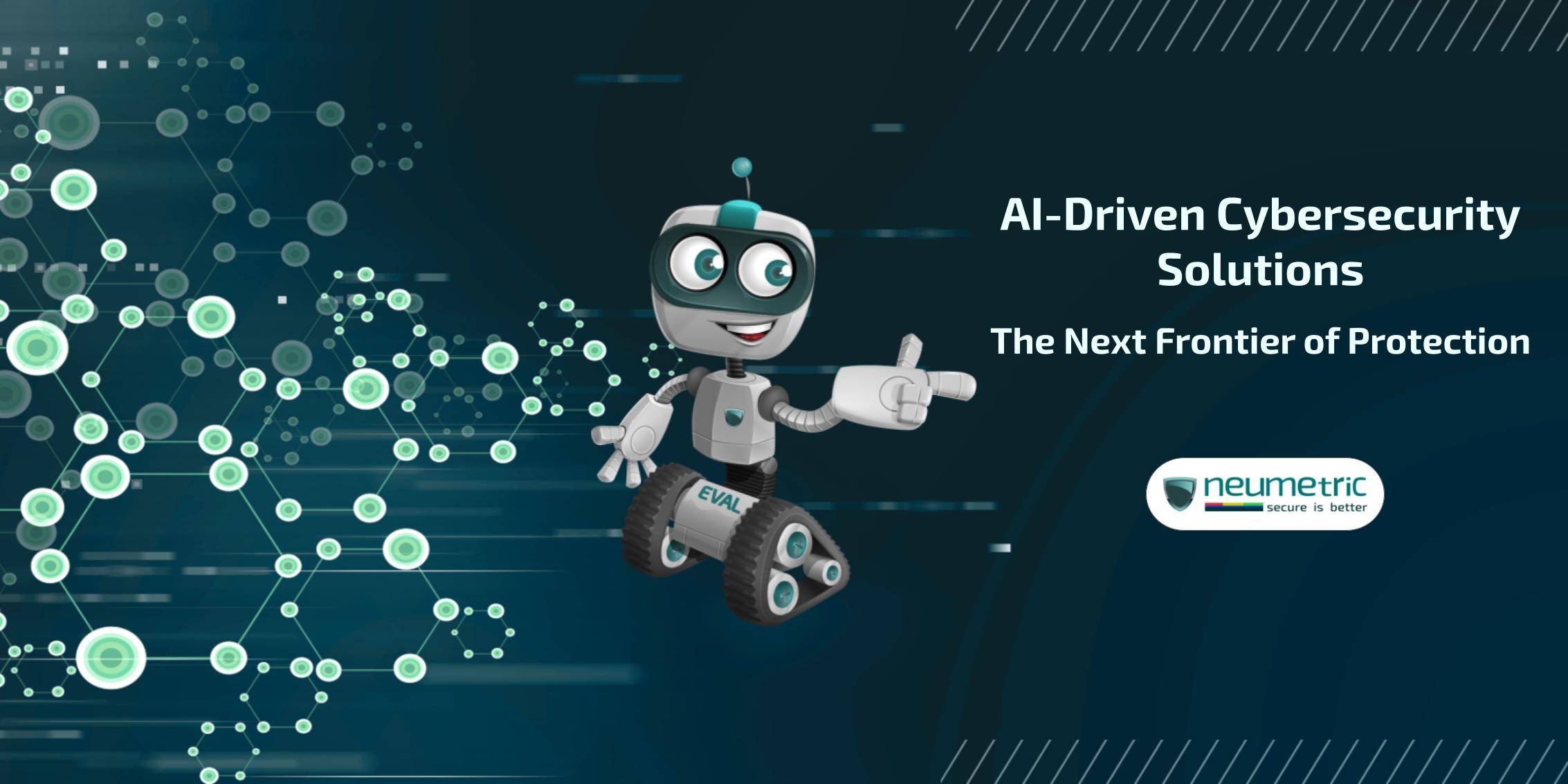Table of Contents
ToggleIntroduction
Cyber threats are evolving at an alarming rate, becoming more sophisticated and elusive. As we navigate through an increasingly interconnected digital landscape, the need for robust cybersecurity measures has never been more critical. Traditional approaches are struggling to keep pace with the ever-growing arsenal of cyber threats, making it imperative for us to explore innovative solutions.
The evolution of cybersecurity solutions over the years reflects our continuous battle to stay one step ahead of cybercriminals. From early antivirus programs to complex firewalls and intrusion detection systems, we’ve witnessed a constant struggle to fortify our digital defences. Despite these efforts, the sheer scale and complexity of modern cyber threats necessitate a paradigm shift in our approach.
Artificial intelligence [AI] has emerged as a game-changer in the realm of cybersecurity. Beyond just a buzzword, AI is proving to be the linchpin in our fight against cyber adversaries. Its role extends far beyond automating routine tasks; it’s a transformative force that empowers cybersecurity measures to adapt, learn & evolve in real-time.
Understanding AI in Cybersecurity
Artificial Intelligence, often referred to simply as AI, is the infusion of intelligence into machines, enabling them to simulate human-like cognitive functions. In cybersecurity, AI goes beyond mere automation, encompassing the ability to learn from experiences, adapt to new information & make decisions without explicit programming.
At its core, AI leverages machine learning algorithms to process vast amounts of data, recognise patterns & discern anomalies. This capability transforms cybersecurity by introducing a dynamic and adaptive layer of defence against evolving threats.
Application of AI in Cybersecurity
- Threat Detection: AI’s application in threat detection revolutionises the cybersecurity landscape. Traditional methods, reliant on static signatures, struggle to keep up with the constantly changing tactics of cybercriminals. AI, on the other hand, employs advanced machine learning models to analyse network behaviours and identify deviations that indicate potential threats. This proactive approach enhances the speed and accuracy of threat detection, allowing organisations to stay ahead of malicious actors.
- Incident Response: In the aftermath of a cyber attack, swift and precise action is crucial. AI contributes significantly to incident response by automating key aspects of the process. Through real-time monitoring and analysis, AI systems can identify the scope and severity of an incident, enabling faster decision-making and response. This not only reduces the impact of the attack but also minimises the time window for adversaries to exploit vulnerabilities.
- Vulnerability Management: Managing vulnerabilities is a perpetual challenge for organisations striving to secure their digital infrastructure. AI addresses this challenge by continuously scanning systems and networks for potential weaknesses. By utilising predictive analytics, AI not only identifies existing vulnerabilities but also predicts future ones based on emerging trends. This forward-looking approach empowers organisations to proactively patch vulnerabilities, fortifying their defences against potential exploits.
The Current State of Cybersecurity
Firstly, the reliance on static signatures for threat detection has become a glaring vulnerability. Cyber threats are no longer monolithic; they morph and adapt, rendering static defences inadequate. The lag between identifying a new threat, developing a signature & deploying it across systems provides a lucrative window for attackers.
Moreover, the sheer volume and complexity of data generated in today’s interconnected world overwhelm traditional cybersecurity tools. Sorting through this data to distinguish genuine threats from background noise is akin to finding a needle in a haystack. As a result, false positives and negatives abound, causing alert fatigue among cybersecurity professionals.
Additionally, the siloed nature of many cybersecurity solutions poses a significant hurdle. These isolated defences often lack the seamless communication needed to provide a comprehensive view of potential threats. It’s like having pieces of a puzzle but no clear picture to guide action.
The Need for Advanced and Adaptive Solutions
The challenges faced by traditional cybersecurity measures highlight the pressing need for solutions that can not only keep pace with the dynamic threat landscape but also outsmart it. Enter the era of advanced and adaptive cybersecurity solutions, where one-size-fits-all approaches are traded for tailored, dynamic strategies. What’s required is a paradigm shift – a departure from reactive measures to proactive, anticipatory defence mechanisms.
The cornerstone of this evolution is adaptability. Cyber threats don’t adhere to a schedule & neither should our defences. Adaptive cybersecurity solutions leverage technologies like artificial intelligence [AI] to continuously learn, predict & adapt to emerging threats in real-time. The need for incident response is also paramount. The longer it takes to detect and neutralise a threat, the more damage it can inflict. Advanced solutions integrate automation into incident response protocols, drastically reducing the time from detection to mitigation.
In essence, the call for advanced and adaptive solutions is a call for a more intelligent, responsive & holistic approach to cybersecurity. It’s an acknowledgment that in the digital realm, staying one step ahead requires more than just a reactive stance – it demands a proactive, anticipatory & dynamic defence strategy.
How AI is Transforming Cybersecurity
As the digital landscape becomes increasingly complex, the marriage of artificial intelligence [AI] and cybersecurity emerges as a game-changer. It’s not just about upgrading defences; it’s about transforming them into dynamic, intelligent guardians. Here’s a closer look at how AI is reshaping the cybersecurity landscape:
Machine Learning Algorithms in Threat Detection
- Anomaly Detection: Imagine your digital space as a bustling city. Anomaly detection is the savvy security guard who notices when something deviates from the norm. In the cyber realm, AI employs machine learning algorithms to establish a baseline of normal behaviour. Any deviation from this baseline triggers an alert, signalling a potential threat. This method goes beyond traditional signature-based detection, which can only identify known threats. Anomaly detection is like having an intuitive security system that recognises suspicious activities, even if they’ve never been encountered before.
- Behavioural Analysis: Picture this as profiling for the digital world but without the stereotypes. AI-powered behavioural analysis delves into the patterns of users and entities within a system. It understands how they typically behave, allowing it to flag any unusual deviations. Think of it as your computer system having a sixth sense – it can identify if a user is accessing sensitive data at odd hours or from an unusual location. This nuanced understanding of behaviour enhances the ability to pinpoint potential insider threats or compromised accounts.
Predictive Analytics for Proactive Defense
Predictive analytics in cybersecurity is akin to foreseeing a storm before it hits. By analysing historical data and current trends, AI can predict potential future threats. It’s not about waiting for an attack; it’s about anticipating and neutralising threats before they manifest.
Imagine having a weather forecast for cyber threats – predictive analytics enables organisations to bolster their defences based on insights into likely attack vectors. This proactive stance is crucial in a landscape where cyber threats are as unpredictable as the weather.
Automation and Orchestration for Rapid Incident Response
Automation ensures that repetitive, time-consuming tasks are handled swiftly. Whether it’s isolating affected systems or applying predefined responses to known threats, automation minimises the manual workload, allowing cybersecurity teams to focus on more complex tasks.
Orchestration takes it a step further, coordinating the entire incident response process. Imagine an incident response team working in harmony, each member playing their part seamlessly. Orchestration ensures that different security tools communicate effectively, creating a synchronised defence orchestra that responds rapidly to threats.
In essence, AI transforms cybersecurity from a reactive stance to a proactive, intelligent & swift defence strategy. By harnessing machine learning, predictive analytics & automation organisations can fortify their digital perimeters and stay one step ahead in the ever-evolving cyber landscape.
Key Components of AI-Driven Cybersecurity Solutions
In the dynamic realm of cybersecurity, staying ahead of threats requires more than just reactive measures. The integration of artificial intelligence [AI] into cybersecurity solutions brings forth a new era of proactive, adaptive & intelligent defence. Here are the key components driving this transformation:
Advanced Threat Intelligence
Imagine having a team of cyber-sleuths tirelessly scouring the digital landscape for potential threats. That’s essentially what advanced threat intelligence does. It goes beyond traditional threat feeds, leveraging AI to analyse vast amounts of data, identifying patterns & predicting potential threats.
This component acts as the digital detective, providing organisations with timely and relevant information about emerging threats. From the dark web to the far reaches of the internet, advanced threat intelligence ensures that cybersecurity teams are equipped with the knowledge needed to pre-emptively defend against evolving threats.
Endpoint Protection Powered by AI
Endpoints, including devices like laptops, smartphones & servers, often serve as the front lines in the battle against cyber threats. AI-powered endpoint protection takes this defence to a whole new level.
Think of it as having a vigilant sentry stationed at each digital entry point. AI continuously monitors and analyses activities on these devices, identifying potential threats in real-time. By learning from user behaviours and detecting anomalies, endpoint protection powered by AI ensures that even the sneakiest threats are neutralised before they can cause harm.
Cloud-Based Security Solutions
With the proliferation of cloud services, securing digital assets has expanded beyond traditional boundaries. AI-driven cloud security solutions act as the guardian of virtual landscapes, offering scalable and adaptive defence mechanisms.
This component secures data stored in the cloud, monitors cloud infrastructure for potential vulnerabilities & applies AI-enhanced threat detection to protect against cloud-based attacks. It’s like having an ever-watchful cloud companion, ensuring that the advantages of cloud computing come without compromising security.
Network Security with AI Capabilities
Securing the intricate web of networks requires more than just traditional firewalls and intrusion detection systems. AI-infused network security is the vigilant gatekeeper, actively monitoring network traffic, identifying unusual patterns & thwarting potential threats.
Think of it as having an AI-powered traffic cop, directing the flow of data and ensuring that any suspicious activities are flagged and investigated. By continuously learning from network behaviours, this component adapts to evolving threats, fortifying the digital highways against cyber adversaries.
In essence, these key components form the backbone of AI-driven cybersecurity solutions. By integrating advanced threat intelligence, AI-powered endpoint protection, cloud-based security & network security with AI capabilities, organisations can construct a comprehensive defence strategy that adapts to the ever-changing landscape of cyber threats. It’s not just about preventing attacks; it’s about orchestrating an intelligent and proactive defence.
Challenges and Ethical Considerations
As we dive into the realm of AI-driven cybersecurity solutions, it’s crucial to acknowledge not just the promises but also the challenges and ethical considerations that come with this technological frontier.
Addressing Concerns about AI in Cybersecurity
The integration of AI in cybersecurity, while promising enhanced protection, raises valid concerns. One primary worry is the potential for AI systems to produce false positives or negatives, leading to unnecessary panic or overlooking actual threats. Addressing these concerns involves continual refinement of AI algorithms, ensuring they evolve to understand and adapt to an ever-changing threat landscape.
Moreover, the opacity of AI decision-making processes can be disconcerting. Striking a balance between the complexity of algorithms and transparency in their functioning is essential. Open dialogue and collaboration between cybersecurity professionals, developers & end-users can help demystify AI and build trust in its capabilities.
Ensuring Transparency and Accountability
The lack of transparency in AI algorithms can pose a challenge, especially when it comes to accountability. Understanding how AI systems reach decisions is crucial for validating their outcomes. Developers must prioritise transparency, providing clear insights into the decision-making processes of AI-driven cybersecurity solutions.
Furthermore, accountability should not be confined to just technological aspects. There needs to be a clear delineation of responsibilities among developers, cybersecurity teams & end-users. Establishing accountability frameworks ensures that if a security breach occurs, the responsible parties can be identified and held accountable.
Ethical Use of AI for Cybersecurity Purposes
As AI becomes a cornerstone in cybersecurity defence, ethical considerations must be at the forefront. Ensuring that AI is used for the betterment of security without compromising individual privacy is paramount. Striking the right balance between surveillance for protection and preserving user privacy requires careful navigation.
Ethical guidelines should be established, guiding the development and deployment of AI-driven cybersecurity solutions. This includes respecting user consent, anonymizing data wherever possible & avoiding the use of AI for malicious purposes. Ethical frameworks serve as a compass, guiding the responsible and principled use of AI in the realm of cybersecurity.
Recommendations for Businesses and Individuals
In light of the challenges and ethical considerations, it’s imperative for both businesses and individuals to navigate the evolving landscape of AI-driven cybersecurity responsibly.
- Importance of Embracing AI-Driven Cybersecurity Solutions: The first and foremost recommendation is to recognise the importance of embracing AI-driven cybersecurity solutions. As threats become more sophisticated, traditional defences fall short. Embracing AI is not just about adopting cutting-edge technology; it’s about investing in a proactive defence strategy that evolves with the threat landscape.
- Strategies for Implementation and Integration: Implementation of AI-driven cybersecurity solutions should be strategic and well-planned. Businesses should conduct thorough risk assessments to identify specific vulnerabilities and tailor AI implementations accordingly. Integrating AI seamlessly into existing cybersecurity frameworks requires a phased approach, ensuring minimal disruption to operations.
- Training and Awareness for Cybersecurity Best Practices: No cybersecurity solution, AI-driven or otherwise, can be effective without an informed and vigilant user base. Both businesses and individuals need to invest in continuous training and awareness programs. Understanding the capabilities and limitations of AI-driven solutions is key. Individuals should be educated on best practices for maintaining cybersecurity hygiene, recognising phishing attempts & adapting to the evolving threat landscape.
Conclusion
In conclusion, the role of AI in cybersecurity is paramount, marking a transformative shift in defence strategies. As cybersecurity measures continually evolve, AI stands as the driving force, adapting and responding in real-time to emerging threats. The key takeaway is the necessity for a proactive approach – an acknowledgment that anticipating and preparing for cyber threats is as crucial as responding to them. Embracing AI-driven solutions, investing in ongoing training & fostering adaptability are essential steps toward building resilient defences in our ever-changing digital landscape.
Frequently Asked Questions [FAQ]
How does AI-powered cybersecurity differ from traditional security measures?
AI-driven cybersecurity is like having a proactive digital guardian. Unlike traditional methods that rely on predefined rules, AI dynamically learns, adapts & anticipates threats in real-time. It’s more like a savvy teammate that evolves with the ever-changing cyber landscape.
Is there a risk of AI-driven systems making errors or false alarms in cybersecurity?
Absolutely, it’s a valid concern. AI is powerful, but not infallible. There’s always a chance of false positives or negatives. However, constant refinement of AI algorithms, coupled with transparent processes, is the key. It’s about finding that sweet spot where technology complements human oversight.
How can businesses and individuals best prepare for the integration of AI in cybersecurity?
Think of it as gearing up for a digital evolution. Businesses should conduct thorough risk assessments, plan strategic AI implementations & invest in ongoing training. For individuals, staying informed, recognising common cyber threats & adapting to new security practices are crucial. It’s all about a joint effort in navigating the cyber landscape safely.





